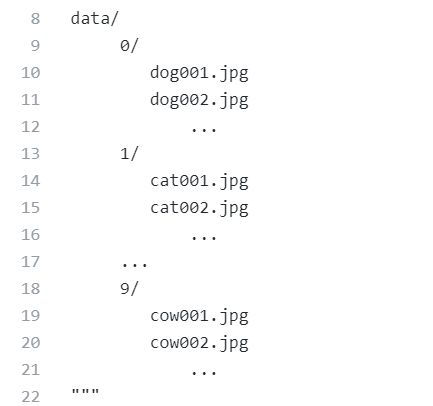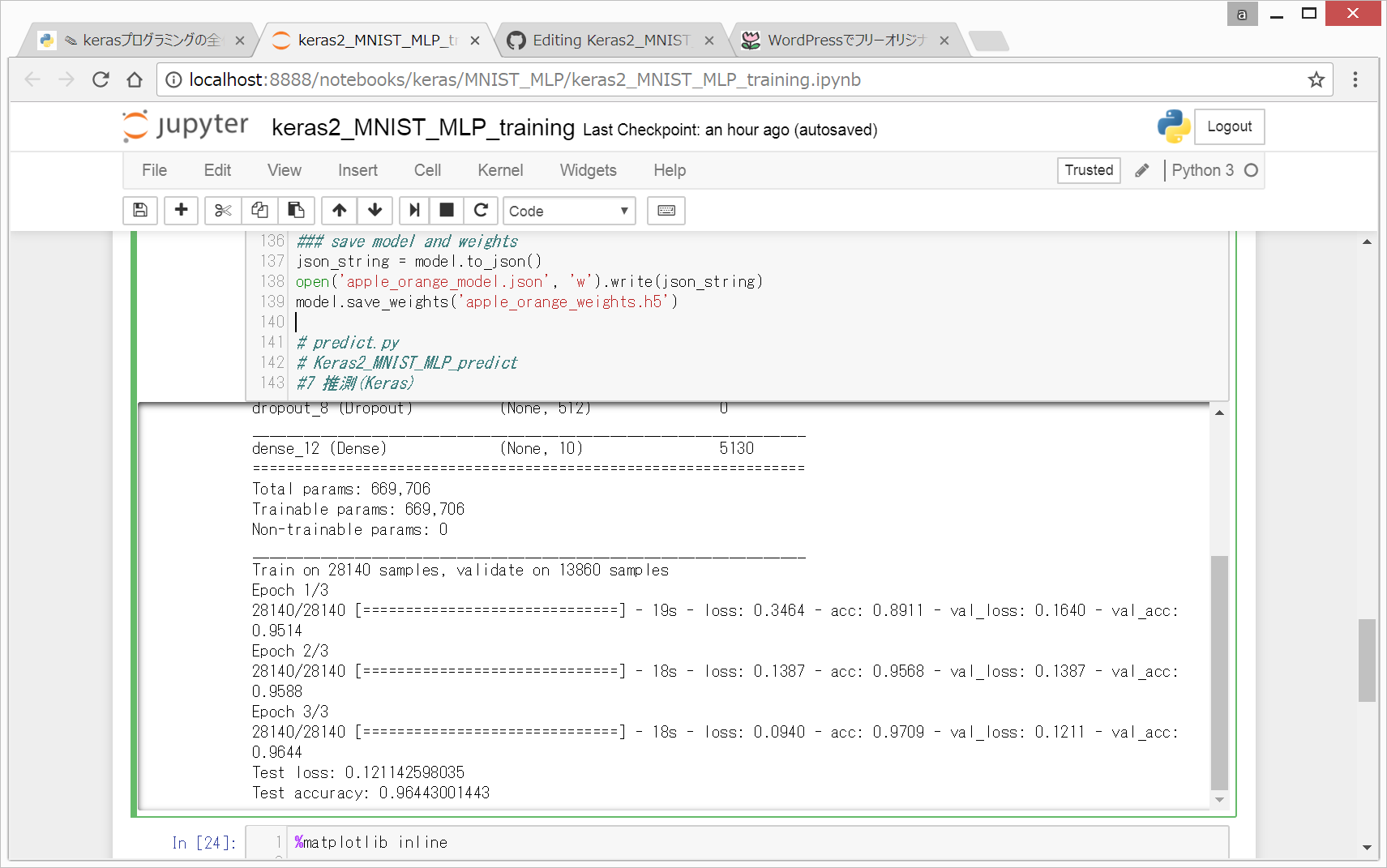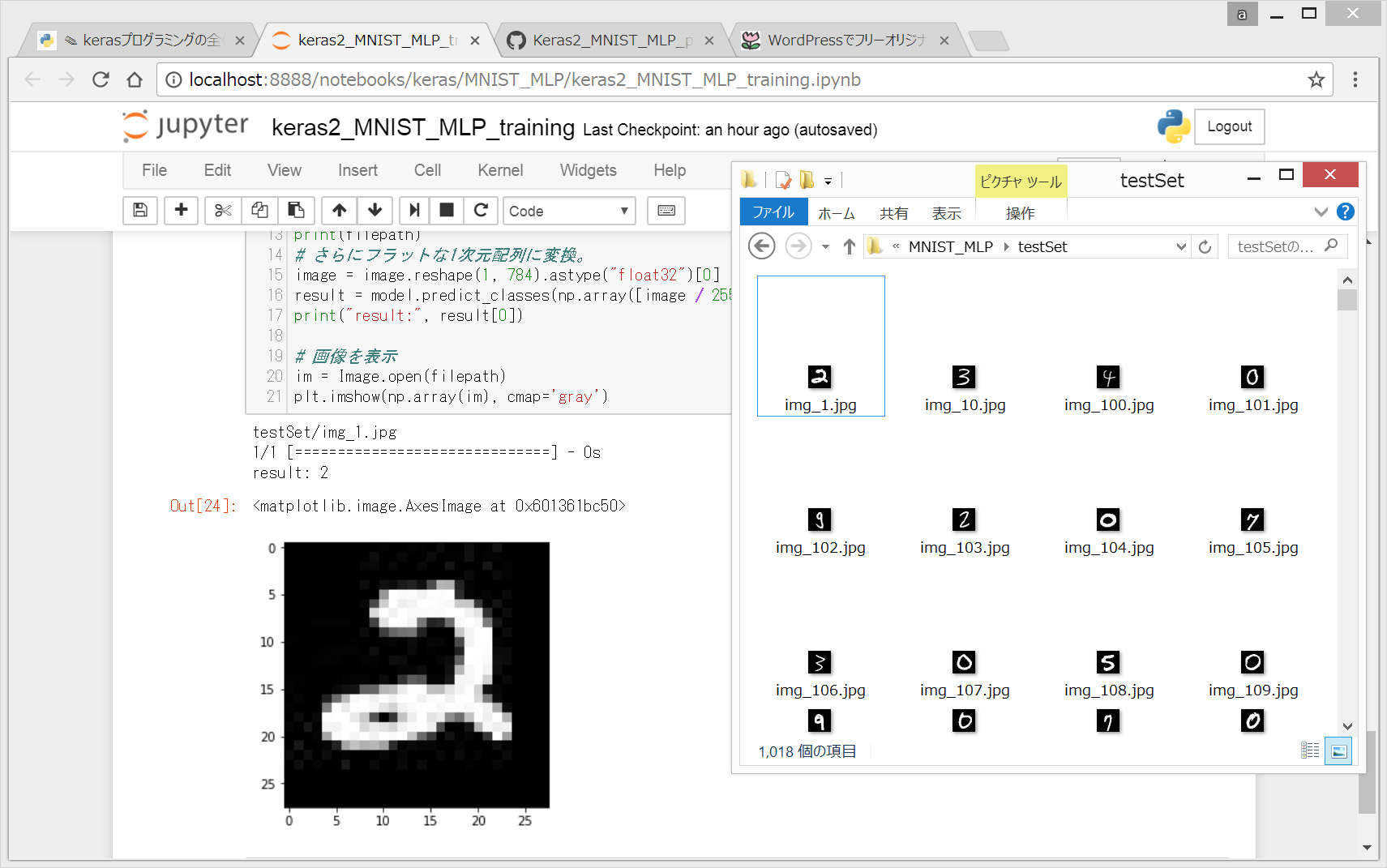目次
Kerasプログラミングの全体図
Keras2でMNIST目次
Kerasプログラミングの全体図
Kerasを用いて機械学習を行う場合、以下のような流れでプログラミング文を読んだり書いたりしていくと、分かりやすいと思います。
実際に自前データを動かそうとするときは、ある程度、pythonの勉強と、機械学習の勉強が必要だと思われます。
# train.py #1 Kerasを使用するためのimport文 #2 データ準備(Keras) #3 モデル設定(Keras) #4 モデル学習(Keras) #5 結果の出力(Keras) #6 学習結果の保存(Keras) # predict.py #7 推測(Keras)
Kerasプログラミングの全体図(コード記載)
上記にコードの一部を入れて、再度記載します。
# train.py
#1 Kerasを使用するためのimport文
import keras
from keras.models import Sequential
from keras.layers import Dense, Dropout
from keras.optimizers import RMSprop
from keras.utils import np_utils
# その他、以下が必要になることが多い
from sklearn.model_selection import train_test_split
import numpy as np
from PIL import Image
import os
#2 データ準備(Keras)
image_list = []
label_list = []
# 画像を読み込み、リサイズ、正規化などを行い、
# Numpy配列に変換し、「学習用データ」と「テストデータ」を作成する。
X_train, X_test, y_train, y_test = train_test_split(image_list, label_list, test_size=0.33, random_state=111)
#3 モデル設定(Keras)
model = Sequential()
model.add(Dense(512, activation='relu', input_shape=(784,)))
model.add(Dropout(0.2))
(以下、model.add()でモデルを加えていき、)
model.summary() # モデルの表示
model.compile(loss='categorical_crossentropy',
optimizer=RMSprop(),
metrics=['accuracy']) # 損失関数、最適化手法などを設定
#4 モデル学習(Keras)
history = model.fit(X_train, y_train,
batch_size=batch_size, epochs=epochs,
verbose=1, validation_data=(X_test, y_test))
#5 結果の出力(Keras)
score = model.evaluate(X_test, y_test, verbose=0)
print('Test loss:', score[0])
#6 学習結果の保存(Keras)
json_string = model.to_json()
open('apple_orange_model.json', 'w').write(json_string)
model.save_weights('apple_orange_weights.h5')
# predict.py
#7 推測(Keras)
from keras.preprocessing import image
import numpy as np
import sys
filepath = "(予測したいファイルのPATH)"
image = np.array(Image.open(filepath).convert("L").resize((28, 28)))
print(filepath)
image = image.reshape(1, 784).astype("float32")[0]
result = model.predict_classes(np.array([image / 255.]))
print("result:", result[0])
Kerasプログラミングの例(train.pyとpredict.py)
train.py
<html>
<script src=“https://gist.github.com/adash333/5d1fe3b0a17059a3ffe3f16063c59054.js”></script>
</html>
Jupyter Notebookでの実行結果
predict.py
<html>
<script src=“https://gist.github.com/adash333/4812c0c0d2c2daa5db3d848456d96322.js”></script>
</html>
Jupyter Notebookでの実行結果
とりあえず、コードをJupyter Notebook上でコピペして実行するところまででした。
次回から、このコードを順に解説させていただきたいと思います。
参考文献
初めてKerasプログラミングをやるときは、以下の2つの本がおすすめです。ゼロから作るDeep LearningでPythonの基本と理論を学び、詳解 ディープラーニングで、Kerasでの実装方法を学ぶのがよいと思われます。
<html>
<iframe style=“width:120px;height:240px;” marginwidth=“0” marginheight=“0” scrolling=“no” frameborder=“0” src=“rcm-fe.amazon-adsystem.com/e/cm?lt1=_blank&bc1=000000&IS2=1&bg1=FFFFFF&fc1=000000&lc1=0000FF&t=twosquirrel-22&o=9&p=8&l=as4&m=amazon&f=ifr&ref=as_ss_li_til&asins=4873117585&linkId=13a7db2c19cc5f40d6ab48906de8abd1”></iframe>
<iframe style=“width:120px;height:240px;” marginwidth=“0” marginheight=“0” scrolling=“no” frameborder=“0” src=“rcm-fe.amazon-adsystem.com/e/cm?lt1=_blank&bc1=000000&IS2=1&bg1=FFFFFF&fc1=000000&lc1=0000FF&t=twosquirrel-22&o=9&p=8&l=as4&m=amazon&f=ifr&ref=as_ss_li_til&asins=4839962510&linkId=d722909965b5eab4196d370757843f6f”></iframe>
</html>
Keras公式GitHub
keras/examples/mnist_mlp.py
Branch:keras-2
https://github.com/fchollet/keras/blob/keras-2/examples/mnist_mlp.py
kerasのmnistのサンプルを読んでみる
ash8h
2017年07月29日に投稿
https://qiita.com/ash8h/items/29e24fc617b832fba136
次節以降
上記の手書き数字MNISTのMLP(Multilayer perceptron )モデルによる学習を例に、一つずつ解説させていただきたいと思います。
いつもあまり面白くないMNISTですが、Kerasプログラミングを理解する上で避けて通れないので、頑張ってやってみたいと思います。
リンク
Keras2でMNIST目次
Kerasプログラミングの全体図



